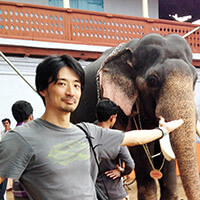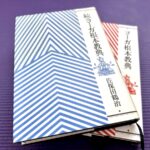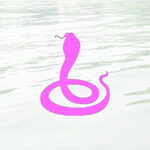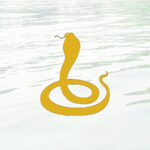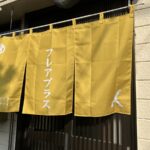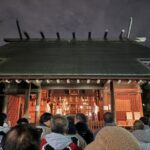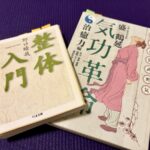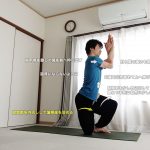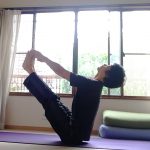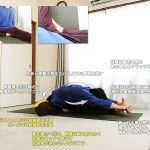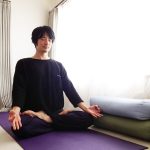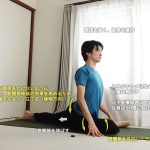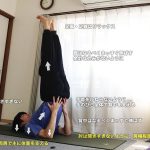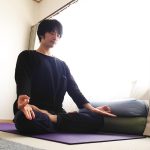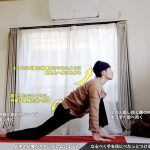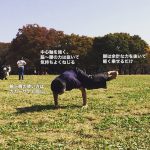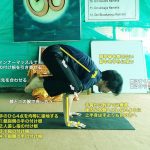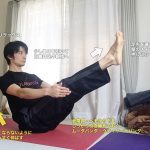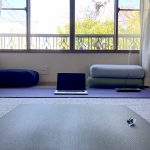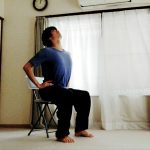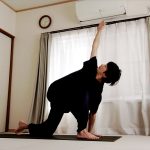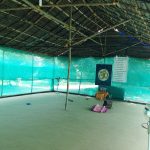「クンダリニー・タントラ/スワミ・サティヤナンダ・サラスワティ著」を読み進めていく形で、クンダリーニヨガ(クンダリニーヨーガ)の概要を紹介していく連載記事です。
「Kundalini Tantra 英語版 ペーパーバック」 Swami Satyananda Saraswati (著)
「Kundalini Tantra 英語版 Kindle」 Swami Satyananda Saraswati (著)
今回は、第3章の4節、アージュニャーチャクラの覚醒方法に関する部分です。
「आज्ञा ājñā アージュニャー」というサンスクリット語は、「司令塔」「監視塔」といった意味です。日本語にはない発音なので、カタカナ表記にも「アジュニャー」「アジナー」「アジナ」など様々なバリエーションがあります。
「第三の目」「サードアイ」などと呼ばれることもあるチャクラです。アージュニャーチャクラ自体の詳しい説明は、以下の記事を参考にしてください。
以下、引用部分の太字強調は私が個人的に重要と思ったところを示したものです。
アージュニャーチャクラ覚醒の流れ
この節から、1ヶ月ごとにひとつのチャクラの覚醒を目指すという流れで、アージュニャーチャクラから順番に各チャクラの覚醒方法が示されていきます。
Month 1
Direct concentration on ajna chakra is very difficult, and for this reason, in tantra and yoga the mid-eyebrow center (which in fact is the kshetram of ajna), is used to awaken this chakra.
アージュニャーチャクラは頭の中心付近にあり、しかもそのあたりには重要な器官が密集しているため、直接アージュニャーチャクラへ意識を集中することは難しいといわれます。
そのため、タントラやヨーガでは、アージュニャーチャクラのクシェートラム(対応する体表の点)である「眉間」をチャクラ覚醒に用います。
Firstly, there is an important shatkriya (cleansing technique) called trataka, which will aid in the awakening of ajna. It is a powerful technique which can be denned as ‘fixed gazing at one point’. If practised regularly, it develops the power of concentration, and from this concentration, the direct awakening of the latent faculties of ajna chakra is brought about.
アージュニャーチャクラ覚醒のための重要な技法として、まず「トラータカ(トラタカ)」という浄化法が挙げられています。
これは最近も紹介した鼻洗浄のネティなどとともに、ハタヨーガの6つの浄化法「シャットカルマ」に含まれています。
トラータカのやり方は、基本的には「一点をしっかり見つめて集中する」という行法で、よくロウソクなどを用います。効果としては、強い集中力を養い、その深い集中によってアージュニャーチャクラの秘められた機能が現れてくる、と説明されています。
Ajna can also be contacted by concentrating on the nadis directly. The method for this is anuloma viloma pranayama, which is known in English as ‘the coming and going pranayama’.
アージュニャーチャクラに直接集中することは難しいですが、イダー・ピンガラーの2本ナディを用いて集中することも可能であり、そのために用いられるのが「アヌローマ・ヴィローマ・プラーナーヤーマ(片鼻呼吸法)」です。
参考:アヌローマヴィローマプラーナーヤーマ(ナディショーダナ・片鼻呼吸法)の効果・やり方
You can also awaken ajna chakra by concentrating on the eyebrow center, by such practices as shambhavi mudra. Initially, when there is no sensation or awareness at this point, some ointment or oil such as tiger balm can be applied. This facilitates concentration. With practice, the pressure of concentration at this area increases and the sensations are carried back to the pineal gland. This brings about an awakening there in the form of visions and internal experiences.
眉間への集中によってアージュニャーチャクラを覚醒させる具体的なやり方として、眼を上へ向けて寄り目にするようにして眉間を凝視する「シャーンバヴィー・ムドラー」などが用いられます。
最初のうちは、眉間に集中しても何も感じることがなかったり、眉間の正確な場所が把握できていないこともあるので、たとえばタイガーバームのような軟膏を眉間に塗ることで意識しやすくすることもできる、と説明されています。私もインドで眉間にサンダルウッドのペーストを塗られました。

眉間への集中による圧は、脳の中央付近にある松果腺へと伝わり、なんらかの視覚的なビジョンや内的経験の形で覚醒をもたらすといわれます。
Ajna and mooladhara chakras are closely related, and the awakening of one helps to awaken the other. Ideally, ajna should be awakened to some extent before mooladhara, in order to allow an unaffected perception of the energies manifested by mooladhara and the lower chakras. However, the awakening of mooladhara will help to further awaken ajna. In fact, the best way to bring about awakening of ajna is through the practices of moola bandha and ashwini mudra which are specific for mooladhara.
アージュニャーチャクラとムーラーダーラチャクラは密接に関係していて、一方が覚醒すると、他方の覚醒を助けることができると説明されています。
サティヤナンダ氏のクンダリニーヨーガの手順では、アージュニャーチャクラを最初に扱うということがこれまでもたびたび説明されてきました。
アージュニャーチャクラを先に覚醒させておくことによって、ムーラーダーラチャクラやスワディシュターナチャクラのような低位のチャクラが覚醒した際の感情的なエネルギーの現れ、例えば性的エネルギーの現れなどにも影響を受けないようにすることができるといいます。
しかしムーラーダーラチャクラの覚醒もまた、アージュニャーチャクラの覚醒を助けることができるため、実際のところベストな道としては、アージュニャーチャクラの覚醒に際して、ムーラーダーラチャクラ覚醒のために用いられるムーラバンダ(会陰の収縮)やアシュウィニムドラー(肛門の収縮)なども用いると良い、と説明されています。
このように示されていますが、この節ではひとまず前半に述べられた以下の3つの行法が解説されています。
- アヌローマ・ヴィローマ・プラーナーヤーマ(片鼻呼吸法)
- トラータカ(ロウソクなどを凝視する)
- シャーンバヴィー・ムドラー(眉間を凝視する)
ムーラバンダ(会陰の収縮)やアシュウィニムドラー(肛門の収縮)については、次節のムーラーダーラチャクラの覚醒方法の中で説明されます。
This sadhana (consisting of practices 1, 2 and 3), for ajna chakra, should be continued daily for one month. Then proceed to the sadhana for awakening mooladhara chakra.
まずは以上の3つを1ヶ月間毎日しっかり練習した上で、ムーラーダーラチャクラの行法へ移っていくべしと指示されています。
アージュニャーチャクラの行法の準備
Jala and sutra neti can be practised for a few months to purify the nasal area. This will help to sensitize ajna chakra and aid in its awakening. Apart from having a profound effect on the nervous system, neti removes dirt and mucus from the nasal passages, relieving colds and sinusitis, disorders of the eyes, ears, nose and throat, as well as inflammation of the tonsils, adenoids and mucus membranes.
ジャラネティやスートラネティを数ヶ月行うことで、鼻腔など鼻の中の浄化を行っておくことができ、これがアージュニャーチャクラへの知覚を鋭くし、覚醒の助けになるといいます。
またそれだけでなく、目や耳や喉もスッキリするなど、日常的にも様々なメリットがあります。
ジャラネティは私も毎朝やっていてよく記事でも紹介していますが、生理食塩水で鼻を洗浄する浄化法です。
参考:ネティ(ネーティ・ジャラネティ・鼻洗浄・鼻うがい)のやり方
スートラネティは、細いゴムの糸・カテーテルなどを鼻から入れて口から出し、鼻の奥から喉のあたりを浄化するもので、私はたまに行っています。「ジャラ(ジャーラ)」の意味は「水」で、「スートラ」の意味は「糸」です。
行法1:アヌローマ・ヴィローマ・プラーナーヤーマ
一般的な片鼻呼吸法は、手を使って片方の鼻の穴をふさいで行いますが、ここで示されている片鼻呼吸法は、実際には片鼻をふさがず、左鼻を通って吸う→右鼻を通って吐く→…という「イメージ」で行うものです。
イメージだけで意味があるのか?という疑問が生まれるかもしれませんが、イメージにこそ意味があるのだと思います。イメージに従って、プラーナは流れます。プラーナーヤーマは、空気を出し入れしているだけでなく、プラーナを呼吸しているということです。
呼吸法の練習のとき、イメージを伴わずに淡々と空気の出し入れだけしている人も多いかもしれませんが、まあそれなりの効果は、あると思います。
Sit in a comfortable meditative posture. Make sure the spine is erect and the body is relaxed. The body must become absolutely still. After some minutes, begin to develop awareness of the breath in the nostrils. When you breathe in, your whole awareness should flow with the breath from the tip of the nose, through the nasal passages, up to the eyebrow center. And when you breathe out, your whole awareness should flow with the breath from the eyebrow center to the tip of the nose.
快適で瞑想に適した坐法で坐ります。背骨は垂直に立て、体はリラックスして、完全に安定しているようにします。
数分間坐った後、鼻孔を通る息に、気づきを向けていきます。
息を吸うとき、鼻先から鼻道を通って眉間へ上がっていく息の流れに、全ての気づきを向けておく必要があります。
息を吐くときはその逆に、眉間から鼻道を通って鼻先から出ていく息の流れに、全ての気づきを向けます。
Become aware of the triangular form of the breath between the nostrils and the eyebrow center. The base of the triangle is at the level of the upper lip, its sides are the right and left nasal passages, and its apex is within the eyebrow center. Firstly, feel the breath moving in and out of the left nostril, then the right nostril. Then be aware of the breath as it flows in and out through both nostrils together.
眉間を頂点として、両鼻を通る息の道筋を結んだ線と、上唇のあたりに引いた横の線を結んだ、三角形をイメージします。
まず左鼻だけから息を吸って吐くというイメージをします。次に、右鼻でも同様に行います。そして、両鼻から同時に行うイメージをします。
Once you are established in this breath awareness, begin to consciously alternate the flow of the breath between the two nostrils in the same way as nadi shodhana, except you practise it psychically. Consciously inhale through the left nostril to bhru-madhya and exhale through the right, then inhale through the right txTbhrumadhya, and exhale through the left. This is one round-After completing four such rounds, inhale and exhale through both nostrils simultaneously, visualizing the passage of the breath forming an inverted V-shape. In this way you have to continue – four alternate nostril breaths, then one breath through both nostrils. Count the rounds from 100 back to zero.
100 – inhale left nostril, exhale right nostril; inhale right nostril, exhale left nostril, 99 – repeat, 98- repeat, 97- repeat, 96- inhale both nostrils, exhale both nostrils, and so on.
片鼻ずつ、そして両鼻を通る息の流れに気づきを向けることができるようになったら、ここからが本番です。
一般的な片鼻呼吸法(ナディ・ショーダナ)では指で片鼻をふさいで行いますが、ここでは以下の流れを鼻をふさがずに「イメージ」で行います。
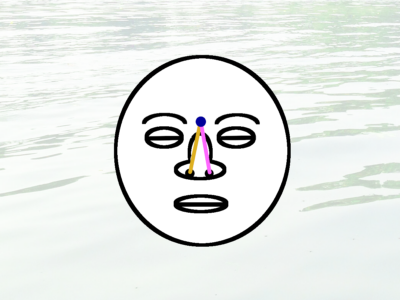
(1)左鼻から眉間へ向かって吸う→右鼻へ向かって吐く→右鼻から眉間へ向かって吸う→左鼻へ向かって吐く
この流れを4回繰り返した後、
(2)両鼻から眉間へ向かって吸って、両鼻から吐く(その際、両鼻と眉間を結ぶ逆Vの字を視覚化する)
を1回行います。
この流れを、100からカウントダウンしていきながら0にたどりつくまで行います。100・99・98・97は(1)、96は(2)を行い、5つカウントダウンするのを1セットとすると20セット行うことになります。
(1)は2呼吸、(2)は1呼吸ということになるので、100呼吸というわけではありません。
理解すれば簡単なことのように思えますが、実はかなりの集中力と時間を要します。
実際その集中力を養うという意味もあるため、「正確性」が一番重要であり、カウントを忘れたり間違えたことに気づいたときは、必ず100に戻ってやり直しなさいという指示があります。
Note: Accuracy in the counting is absolutely necessary, and if an error is made, the practice must recommence from 100. It is very important to keep count of the breaths, because without keeping count, anuloma viloma is altogether too powerful for many aspirants, swallowing up their awareness in the unconscious sphere- The aim of the practice is to stimulate ajna chakra on the subconscious, psychic level, and for this, awareness must be maintained.
If you sink into the unconscious sphere, you will only be aware of the vast store of impressions in the unconscious mind, and will completely lose awareness of the practice. This awareness is essential for the development of mind control and the awakening of ajna chakra to conscious accessibility.
This practice can also be very well integrated into yoga nidra. (See practice chapter 2)
最後にこの行法の目的と注意点が書かれています。
これを行うことによって、無意識の領域への気づきが生まれ、それこそがアージュニャーチャクラを潜在意識・霊的レベルで刺激することになるので、必ず気づきを維持しながら行うべし、と指示されています。
もし無意識の領域へ沈んでしまうと、無意識の心に蓄積された膨大な印象に気づくだけになり、行法への気づきは完全に失われるといいます。
私もよく経験しましたが、途中で夢を観ているような状態になってしまい、完全に数を忘れてしまいます。それはそれで夢見心地の状態に意識的に入ることができて気持ち良いのですが、それは本来の目的からは外れています。ただ、この行法はヨガニドラーの実践と統合することもできるとも示されており、睡眠や夢とも大きく関係があると思われます。
100数え切るまで意識的な気づきを持ち続けることが、心をコントロールし、アージュニャーチャクラを覚醒させ、チャクラを意識的に用いることができるようになるために必要なものである、と説明されています。
行法2:トラータカ
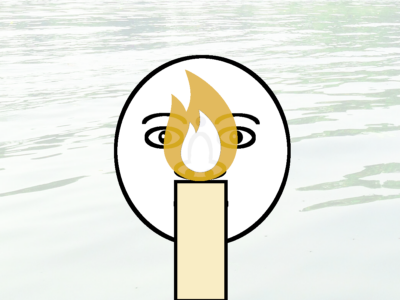
Sit in a comfortable meditative asana, in a dark room in which there is no draught or breeze.
Place a lighted candle at eye level, directly in front of the eyebrow center, at a distance of approximately two feet.
Make sure that the wick is perfectly straight and that the flame is motionless. Straighten the spine, close the eyes and relax the body.Be aware of the physical body only. Let it become as still as a statue. From this time on you should try to keep the body absolutely motionless throughout the whole practice.
すきま風などのない無風の暗い部屋に、快適で瞑想に適した坐法で坐ります。
火を灯したろうそくを、炎が眉間の正面にくる高さで60cmくらい前方に置きます。
60cmは、腕を前に伸ばしたくらいの距離を目安にすると良いでしょう。
床に置いたのでは見下ろす形になってしまうので、机などに置いて高さを調整します。
ろうそくの芯はまっすぐに立て、炎が揺れないようにスキマ風の入らないようにしておきます。
背骨を伸ばし、目を閉じて体をリラックスします。意識は肉体にだけ置いて、石像のように安定させます。トラータカの実践の間、体は全く動かないように保てるように練習します。
When you are prepared, open your eyes and gaze intently at the brightest part of the flame – just above the tip of the wick.
With practice you should be able to gaze at the flame for a few minutes, without blinking or moving the eyeballs.
Continue to gaze at the flame with total concentration. The whole of your consciousness must become centered in the flame, to the extent that awareness of the rest of the body and the room is lost.
The gaze should be absolutely fixed on one point.
体を不動に保てるように準備ができたら、目を開けて、炎の最も明るいところ(ろうそくの芯のすぐ上あたり)を意識的に凝視します。瞬きをせず、眼球を動かすことなく、炎を数分間見つめ続けます。全ての集中を炎へ向け、体や周りの空間への意識はなくなります。一点を、凝視し続けます。
When the eyes become tired (perhaps after a few minutes), or if they begin to water, close them and relax.
Do not move the body, but be aware of the after-image of the flame in front of the closed eyes.
Everyone has looked into the sun or a bright light, and on closing the eyes for a few minutes, has seen the clear impression of that light on the retina of the eye. Likewise, the after-image of the candle flame will be clearly visible.
You should practise trataka on this image, holding it directly in front or a little above the eyebrow center-As soon as it begins to fade, open the eyes again and continue to concentrate on the external candle flame.
数分後に目が疲れてきたり涙がたまってきたりしたら、目を閉じてリラックスします。
体は動かすことなく、網膜に残った炎の形を見つめ続け、眉間の少し上あたりに炎のイメージが見えるように保ち続けます。
その網膜のイメージが消え始めたら、目を開けて、炎を見つめるのを再開します。(体が不動であれば、炎のイメージの位置がブレることなく、同じ位置になるはずです)
(このように網膜に残ったイメージを用いる行法は、オーラ視に関する行法にもよく用いられます。実際オーラといったものは、これと同じように、光で見えている世界と重なって見えるように知覚されます。)
Note: The best times to practise trataka are the dark hours of the very early morning or late at night. At these times, the atmosphere becomes very still and quiet – not only the physical atmosphere, but the mental and psychic atmospheres also. In this stillness, success in trataka is readily attained.
トラータカを行うのに最適なのは暗い時間帯であり、早朝や深夜などが適していて、そういった時間帯は物理的にも心理的・霊的にも空気が安定して静かであり、そういった安定性がトラータカの成功をもたらすと説明されています。
Duration: Trataka can be practised as time permits, but 15 to 20 minutes is the usual period in the beginning.
Benefits: Trataka has many physical, mental and spiritual benefits. Physically, it corrects eye weaknesses and certain defects such as nearsightedness. Mentally, it increases nervous stability, removes insomnia and relaxes the anxious mind. When the eyes are fixed and unmoving, the mind becomes the same. The thinking process automatically ceases as concentration increases. It brings control to the tempestuous mind, and spiritually it awakens ajna chakra.
少し本文とは順番が変わりますが、トラータカを実践する時間(長さ)と効果について述べられています。
トラータカは時間が許す限り長時間行っても良いが、最初のうちは15〜20分くらい行うのが標準的であろう、と指示されています。
トラータカは、肉体的にも、心や霊的にも多くの効果があるといわれます。肉体的には、近視などの視力異常を改善し、精神的には、神経の安定性をもたらして不眠症を改善し、リラックスして不安のない心をもたらすといいます。目を動かさずにキープできるようになれば、心も同じように不動にすることができる、と説明されています。散乱していた思考は止まり、集中力が高まり、そしてアージュニャーチャクラの覚醒をもたらす、と述べられています。
他のやり方のトラータカ
Trataka can be practised on a small dot, the full moon, a shadow, a crystal ball, the nosetip, an image in water, a yantra, darkness, a shivalingam and many other things.
トラータカで凝視する対象は、ろうそく以外にも、小さな点、満月、影、水晶玉、鼻先、水にうつった像、ヤントラ(幾何学模様)、暗闇、シヴァリンガムなど、いろいろなものを用いることができるといいます。
Those who have a personal deity can practise trataka on his or her form and those who have a guru can practise on his or her photograph. Trataka can also be practised on the rising sun, one’s own image in the mirror, or the eyes of another person. These should, however, be done under the guidance of a guru, as there are certain risks involved.
個人的な信仰のある人は、その神様の姿を用いたり、師匠がいるならばその写真を用いたり、朝日、鏡にうつった自分の姿、他人の眼なども用いることができますが、それぞれにリスクもあるので、信頼できる師匠の指示のもとで行うのが良いであろう、と説明されています。
There are two divisions of trataka, bahiranga (outer) and antaranga (inner). The methods mentioned so far are all part of bahiranga trataka. Inner trataka (antaranga) is internal visualization, perhaps of a chakra, a yantra or your personal deity. The eyes remain closed throughout. One of the best inner objects for concentration is a tiny star or point of light.
トラータカには外的なやり方と内的なやり方があり、先に述べられたろうそくを使ったやり方などは外的なやり方です。
内的なやり方のトラータカでは、チャクラやヤントラや自分の進行する神の姿などの内的なイメージを視覚化する方法で行われ、これは常に目を閉じて行います。
集中するための内的なイメージとして最適なもののひとつとしては、小さな星や光である、と説明されています。
行法3:シャーンバヴィームドラー

目玉を上に向けて寄り目にして、眉間を凝視して集中する行法です。3段階に分けて説明されています。
Caution: Do not strain the eye muscles; when they become tired or slightly strained, release shambhavi mudra.
注意点として、目の筋肉を緊張させることのないように、筋肉が疲れたり力んでいることに気づいたら、シャーンバヴィームドラーを解いて休むように、という指示があります。
第1段階
Sit in any meditative pose with the back straight and hands on the knees. Look forward at a fixed point, and then look upward as high as possible without moving the head. Focus the eyes and concentrate on the eyebrow center. Try to suspend the thought processes and meditate on ajna chakra.
瞑想に適した坐法で坐り、背中をまっすぐにして、手は膝の上に置きます。
前方の一点を見つめた後、頭を動かさずにできる範囲で、眼球を上へ向け、眉間を凝視しながら意識をそこに集中します。
雑念をなくし、アージュニャーチャクラへ集中・瞑想します。
Repeat Om, Om, Om, with awareness of the sound vibrations at the eyebrow center into which you are gazing. Each Оm should be produced in a soft clear voice, with awareness of every vibration of the mantra in the eyebrow center. Each mantra should be one or two seconds in duration, and immediately followed by the next. Practise for 3 to 5 minutes.
Omのマントラを、柔らかで清らかな声で繰り返し唱え、凝視している眉間がその音で振動するのを感じます。
一回のマントラは1〜2秒の長さで、間を開けず繰り返し、3〜5分間続けます、
第2段階
Now the eyes are closed, but the inner gaze remains in the eyebrow center. Begin to chant the mantra more slowly, with full awareness of the sound vibration in the eyebrow center. Imagine that the sound is being emitted from within the eyebrow center itself. Gradually and effortlessly increase the duration of each Om, making it long and continuous.
今度は目を閉じて行い、しかし眉間の凝視は続けます。
Omのマントラはよりゆっくり唱え、眉間に響く音の振動に全ての気づきを向けます。その音が眉間の内側から鳴っているようにイメージします。
だんだんとひとつひとつのOmの長さを、ながく途切れることなくしていきます。
The sound should be steady and of an even key, ending on completion of the breath. Then refill the lungs completely by breathing through the nose, but do not alter the position of the body or head. Begin the next Om, maintaining awareness of the sound emerging from the eyebrow center. Practise for 5 minutes.
音は安定しているように、高さも一定にし、そして息を吐ききるまで発音し続けます。
吐ききった後、鼻から息を吸い、肺をいっぱいにします。ただし身体や頭を動かさないようにします。
「眉間から音が鳴っている」というイメージと眉間への気づきを維持しながら、5分間続けます。
第3段階
Continue to chant the mantra Оm, but become aware of the sound reverberating throughout the body. Try to be aware of the sound only, listening to its vibration emerging from the eyebrow center and permeating the whole body. Do not be self- conscious, but allow the sound to manifest itself fully, maintaining awareness of the vibration of the sound only. Practise for 5 minutes. Gradually the duration of the practice can be lengthened.
Omのマントラを唱え続け、体全体に伝わる音の響きに気づきを向けます。
自分が音を発しているという意識を無くしていき、ただ眉間から音が発せられているのを聴いているというイメージで行い、体全体に浸透していく音にただただ気づきを向けるようにします。
最初は5分間行い、この実践はだんだんと長くしていくこともできます。
第2段階と第3段階は、一見したところやっていることは変わらないように見えますが、イメージの上では大きな違いがあり、そういったイメージ力が、チャクラの覚醒には重要な要素になってきます。それに対して「ほんとかなあ」「意味あるのかなあ」などと疑問があるうちは、まだこれらの行法を進めていく段階ではないのかもしれません。
しかしそれは、いくら知識として得ても納得できるものではないので、自分で体験するしかありません。興味があるならば、まずしっかりやり方を学んで実践して、心と体に起こる変化に気づきを向けてみるのが良いかと思います。
次記事:「クンダリニー・タントラ」を読む【42】第3章 5節:ムーラーダーラチャクラの覚醒方法
前記事:「クンダリニー・タントラ」を読む【40】第3章 3節:チャクラ行法の進め方
参考文献
「Kundalini Tantra 英語版 ペーパーバック」 Swami Satyananda Saraswati (著)
「Kundalini Tantra 英語版 Kindle」 Swami Satyananda Saraswati (著)
「クンダリニー」ゴーピ・クリシュナ (著), 中島巌 (翻訳)
「Asana Pranayama Mudra Bandha 英語版」Swami Satyananda Saraswati (著)



